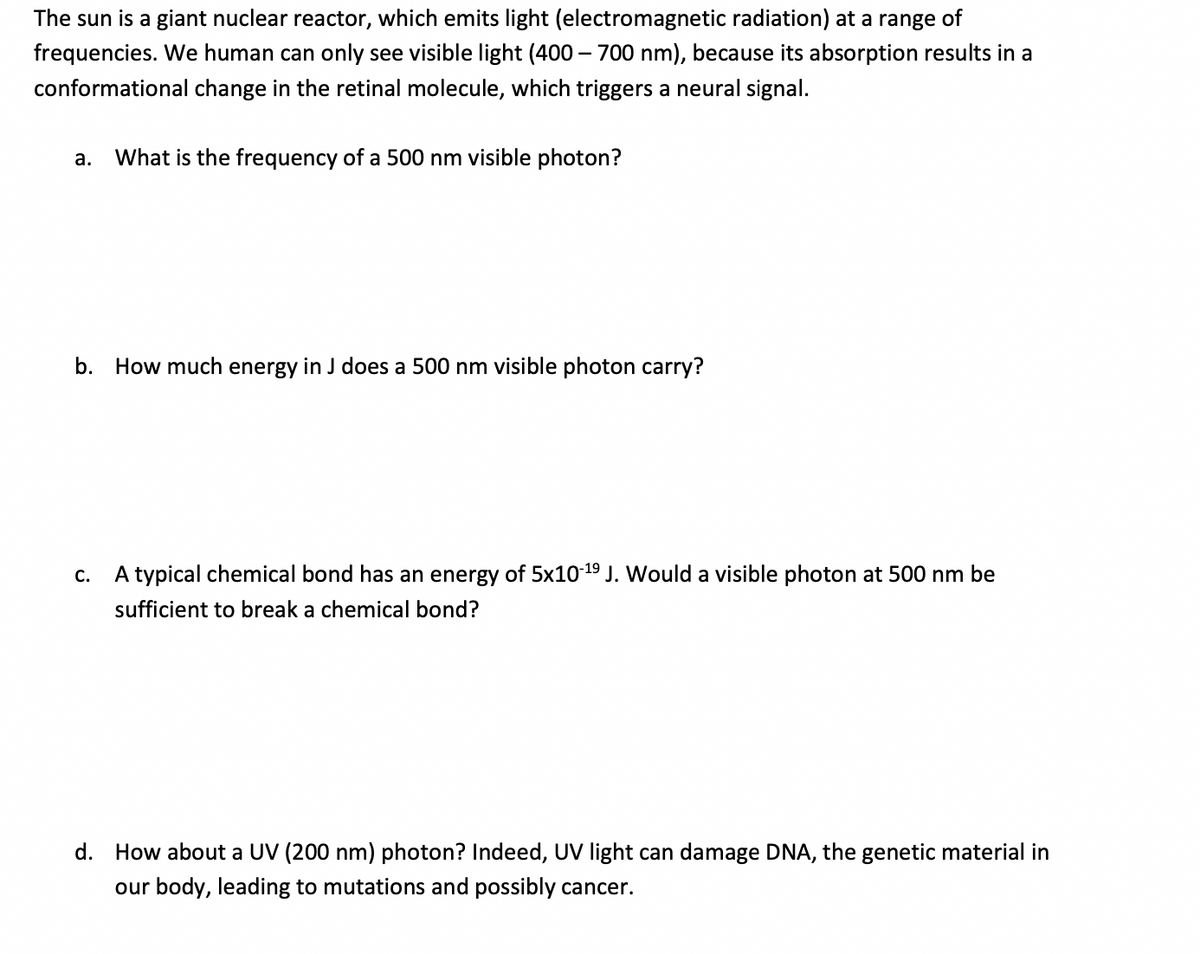The sun is a giant nuclear reactor, which emits light (electromagnetic radiation) at a range of frequencies. We human can only see visible light (400 – 700 nm), because its absorption results in a conformational change in the retinal molecule, which triggers a neural signal. a. What is the frequency of a 500 nm visible photon? b. How much energy in J does a 500 nm visible photon carry? С. A typical chemical bond has an energy of 5x10-19 J. Would a visible photon at 500 nm be sufficient to break a chemical bond? d. How about a UV (200 nm) photon? Indeed, UV light can damage DNA, the genetic material in our body, leading to mutations and possibly cancer.
The sun is a giant nuclear reactor, which emits light (electromagnetic radiation) at a range of frequencies. We human can only see visible light (400 – 700 nm), because its absorption results in a conformational change in the retinal molecule, which triggers a neural signal. a. What is the frequency of a 500 nm visible photon? b. How much energy in J does a 500 nm visible photon carry? С. A typical chemical bond has an energy of 5x10-19 J. Would a visible photon at 500 nm be sufficient to break a chemical bond? d. How about a UV (200 nm) photon? Indeed, UV light can damage DNA, the genetic material in our body, leading to mutations and possibly cancer.
Chapter9: Covalent Bonding: Orbitals
Section: Chapter Questions
Problem 95CP
Related questions
Question

Transcribed Image Text:The sun is a giant nuclear reactor, which emits light (electromagnetic radiation) at a range of
frequencies. We human can only see visible light (400 – 700 nm), because its absorption results in a
conformational change in the retinal molecule, which triggers a neural signal.
a.
What is the frequency of a 500 nm visible photon?
b. How much energy in J does a 500 nm visible photon carry?
A typical chemical bond has an energy of 5x10-19 J. Would a visible photon at 500 nm be
С.
sufficient to break a chemical bond?
d. How about a UV (200 nm) photon? Indeed, UV light can damage DNA, the genetic material in
our body, leading to mutations and possibly cancer.
Expert Solution
This question has been solved!
Explore an expertly crafted, step-by-step solution for a thorough understanding of key concepts.
This is a popular solution!
Trending now
This is a popular solution!
Step by step
Solved in 3 steps

Knowledge Booster
Learn more about
Need a deep-dive on the concept behind this application? Look no further. Learn more about this topic, chemistry and related others by exploring similar questions and additional content below.Recommended textbooks for you


Chemistry
Chemistry
ISBN:
9781305957404
Author:
Steven S. Zumdahl, Susan A. Zumdahl, Donald J. DeCoste
Publisher:
Cengage Learning

Chemistry: The Molecular Science
Chemistry
ISBN:
9781285199047
Author:
John W. Moore, Conrad L. Stanitski
Publisher:
Cengage Learning


Chemistry
Chemistry
ISBN:
9781305957404
Author:
Steven S. Zumdahl, Susan A. Zumdahl, Donald J. DeCoste
Publisher:
Cengage Learning

Chemistry: The Molecular Science
Chemistry
ISBN:
9781285199047
Author:
John W. Moore, Conrad L. Stanitski
Publisher:
Cengage Learning

Chemistry & Chemical Reactivity
Chemistry
ISBN:
9781337399074
Author:
John C. Kotz, Paul M. Treichel, John Townsend, David Treichel
Publisher:
Cengage Learning

Chemistry & Chemical Reactivity
Chemistry
ISBN:
9781133949640
Author:
John C. Kotz, Paul M. Treichel, John Townsend, David Treichel
Publisher:
Cengage Learning

Introductory Chemistry: A Foundation
Chemistry
ISBN:
9781337399425
Author:
Steven S. Zumdahl, Donald J. DeCoste
Publisher:
Cengage Learning